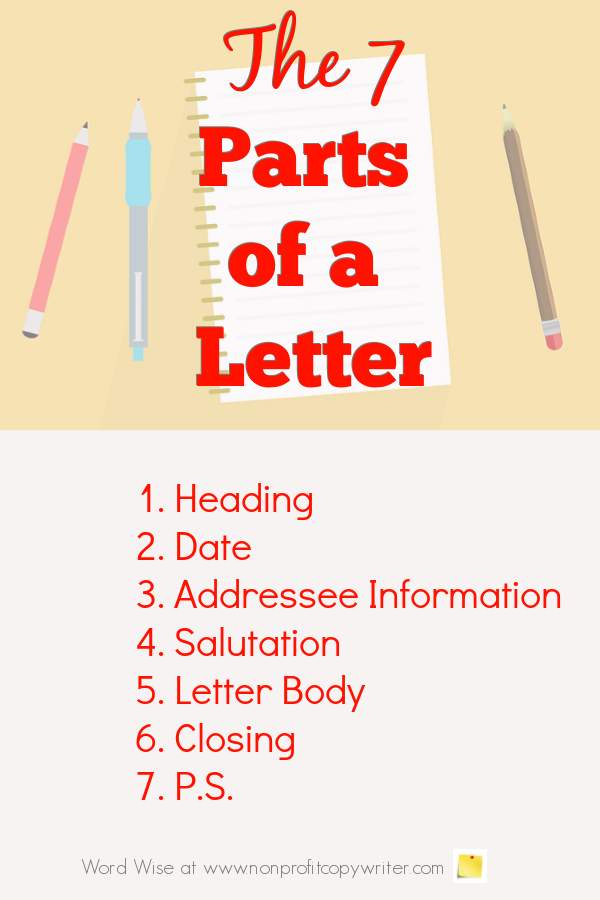Save Time: Get 5 Simple Writing Tips
you can put to use in 10 minutes
The 7 Parts of a Letter
Award-winning writer Kathy Widenhouse has helped hundreds of nonprofits and writers produce successful content , with 750K+ views for her writing tutorials. She is the author of 9 books. See more of Kathy’s content here.
Updated 2.1.25
These seven parts of a letter outline the standard letter writing format for communication in the business and workplace.
1. Heading
Your contact information, placed at the top of a business letter, lets the reader can identify you and provides a way to contact you in return. If you use preprinted letterhead, you have a ready-made heading for your letter. If not, insert your address at the top of the letter, including your street address, city, state, and zip code. You needn’t include your name in your heading since you will sign the letter.
2. Date
Indicate the date you write – or send – the letter. Write out the month, date, and year like this: July 4, 1776.
3. Addressee Information
Also called the “inside address,” this element includes the name of the person to whom you’re writing, his title, the company, and his full mailing address. Make an almost super-human effort to address the letter to a specific individual within a firm even if you must research to identify the appropriate recipient.
Name, job title
Company
Address
City, State, Zip Code
Insert a line space after the addressee information, prior to the salutation.
4. Salutation
The salutation is a greeting made up of two parts: a word of
welcome such as “Dear” and then the individual’s name. Avoid using a generic,
“To Whom It May Concern” or “Dear Gentlemen” but instead, greet the specific
individual or group you listed in the address information. This attention to
detail speaks volumes to the reader.
The salutation can be formal (using the reader’s title, such as Dr., Mr., or Ms., followed by his last name) or informal (using the person’s first name),with the tone matching to the letter’s level of formality. Insert a comma or colon and a line space after the salutation and then proceed to the letter body.
5. Letter Body
The body of letter, the main section, communicates your business. It is comprised of three parts.
- Use the first paragraph as an introduction to explain why you are writing.
- Use the following paragraphs to lay out your points, providing more information and specific details in logical order.
- Use the final paragraph or section to specify what step you want your reader to take after reading your letter. Close this final section with words of appreciation.
As for mechanics, single-space the letter body. Justify the content to the left. Insert a line space between each paragraph and before the closing.
6. Closing
The closing is one of the parts of a letter that, like the letter body, has different elements.
- Complimentary close. This short phrase ends your letter but continues to communicate your tone. Choose a letter closing that suits your relationship with the reader, always communicating courtesy and respect. (Here is a list of the most professional business letter closings.) Follow your closing phrase with a comma.
- Handwritten signature. Insert 2-4 line spaces for a handwritten signature. If your letter will be sent electronically, you can insert an email signature.
- Typed Signature. Type your signature (and your title, if appropriate).
7. Postcript
Among parts of a letter, this element is the most varied. It is also optional.
You may or may not choose to use a postscript (P.S.) in your letter, depending on the letter’s level of formality and its content. When the postscript is short message is inserted after the letter closing, it is abbreviated as “P.S.” It provides a reminder or an extra piece of information for the reader. Formal letters rarely include a postscript. Sales letters and appeal letters, on the other hand, are less formal and nearly always use a postscript, which is considered to be one of the most-read elements in direct mail. (More P.S. writing tips here.)
Cover letters use the postscript section to indicate the inclusion of additional documents (such as a resume, completed application form, references, or other documents) with the abbreviation, “Enc.,” indicating “Enclosures.”
Place your postscript flush left.
More Letter Writing Tips
30 Kinds of Letters You Need to Know How to Write ...
How to Write a Cover Letter: FAQs ...
The basics about writing letters ...
Basic letter writing format: four standard layouts ...
Beyond Yours Truly: Business Letter Closings That Mark You as a Pro ...
Writing a good cover letter: a step-by-step writing guide ...
Cover Letter Writing Tip: get the reader to take one step ...
Letter writing tip: try this opening line ...
How to write a P.S. with punch ...
What your fundraising letter must have ...
3 appeal letter copywriting formulas ...
How to write the perfect donor thank you letter ...
How to Write a Christmas Letter (that people want to read) ...
More letter writing tips on our Pinterest board ...
Return from The Parts of a Letter to Nonprofit Copywriter home
As an Amazon Associate I earn from qualifying purchases.
Share This Page

Named to 2022 Writer's Digest list
BEST GENRE/NICHE WRITING WEBSITE


Stop Wasting Time!
Grab your exclusive FREE guide, "5 Simple Writing Tips You Can Put to Use in 10 Minutes or Less"












